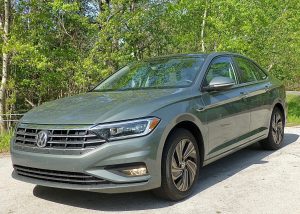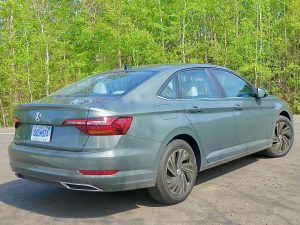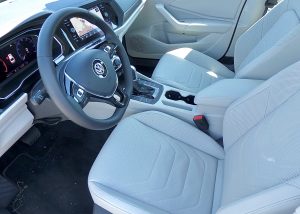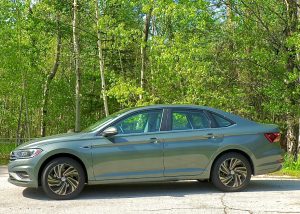Platform, engine, design turn page on Jetta
By John Gilbert
For decades, I’ve been a loyal fan of Volkswagen. It dates back to when I was a kid and my mom bought a 1960 Volkswagen Beetle, equipped to survive Northern Minnesota winters with an add-on gas heater, which was an amazing device that could transform 20-below winter nights — at the pull of a switch to activate the 747-like roar of the under-dash device — to 90 above tropical temperature in about minute, after which you could choose 20 below or 90 above, with no intermediary stops.
Following along through the era of Rabbits, then Golfs, GTIs, Jettas, Passats, with side-trips to a Scirocco or Corrado here or there, our family, and particularly our two sons, got exceptional service from such VWs.
So it was with considerable distress that I followed along with the incredible world-wide scandal of the alteration of VW’s 40-plus miles-per-gallon turbo-diesels, which were configured to disable the emission-control stuff except when being tested by the EPA. It turns out, there have been various other companies caught in the same scandal — including virtually all turbo-diesel pickups from the U.S. — but because of the mountain of publicity, it is VW’s to own, and be fined for.
Most impressive, though, is that Volkswagen didn’t just pull out of the U.S., it made an enormous corporate changeover to rally and stay in the market as a solid performer. Adding SUVs, such as the Tiguan, and the Atlas, helped immeasurably. But with the 2019 Jetta compact sedan, we get to experience the best in German engineering, from a high-tech plant in the U.S., at an amazing bargain price.
Volkswagen, which owns Audi, has worked with them to develop and perfect a couple of 2.0-liter 4-cylinder engines, with and without turbochargers, depending upon the application. VW also reduced the displacement of the 2.0 to 1.8 and got almost as much performance with even better fuel efficiency. In the process, Volkswagen created an all-new platform, called the MQB, which, after translation, stands for Modular Transverse Matrix.
An all-new platform can be significant, allowing a vehicle’s unerpinnings to be designed for stiffness from which high-tech suspension and steering geometry can be engineered to be firmed up, balanced, and safer.
With that MQB basis, the new Jetta adds a striking design. The sixth generation served VW well, outselling the popular Golf in the U.S., but its styling was unobtrusively boring, at best. It looked like a child’s soap-carving — and I liked the car! The new Jetta, hitting showrooms by the end of June, 2018 as a 2019 model, has a neater shape, and a very stylish front end and grille.
It resembles the more costly Passat quite a bit, except that I think the new Jetta leaves Passat and all other VW sedans behind in styling. Interior redesign also has been significant, with a very neat and contemporary instrument panel joined by a center screen, all encircled in a capsulized manner and tilted toward the driver, for a true cockpit design.
With the 1.8 sitting there, awaiting the call to be inserted in the Jetta, Volkswagen went a new direction, creating a 1.4-liter turbocharged 4-cylinder that is the jewel of a whole new family of 4-cylinder engines from VW. The 1.4 TSi doesn’t have the snappy low-end power of the 2.0, but it does have more meaningful torque numbers — peaking at 184 foot-pounds — which overcompensates for the mild 147 horsepower number. It is torque that launches a car’s drive wheels, and while the Jetta isn’t going to be entered in any drag-races, it does take off with adequate punch if you step on it hard enough.
My first chance to drive the Jetta came after I was unable to locate a spot on five waves of its introduction. So when I attened the Midwest Auto Media Association Spring Rally at Elkhart Lake, one new Jetta was assigned there, and it had been arranged that I would drive a 2018 Passat from Duluth to Elkhart Lake, and then get the chance to drive home in the unreleased 2019 Jetta.
It was the opportunity to verify my trust in all things Volkswagen. As gasoline climbs inexorably to, and past, $3 per gallon, you can appreciate this. Driving down from Duluth to the Twin Cities to pick up my older son, Jack, and then drive across Wisconsin to Elkhart Lake, we covered 520 miles — and never needed to fill up the gas tank! It must have a huge tank, but we got a computer suggested 36 miles per gallon with the 2.0 turbo engine.
Returning, two days later, the Jetta felt light and agile, and I cut a few miles off by following the Nav Lady’s recommendations for the shortest routes. Driving across Wisconsin and then Minnesota, we covered 452 miles, and found a way to beat 36 mpg — our trip computed to 44.0 miles per gallon.
Maybe some consumers aren’t yet concerned about gas prices, but I was doubly impressed when I noticed the Jetta calls for regular gas. In our part of the world, premium gas costs about 50 cents more per gallon, and while premium-burning cars run much better on premium, you save a lot at every tankful if it’s $5 cheaper every time you fill.
More important, to every consumer, is the interior of the Jetta, which is filled with very supportive bucket seats that seem much more premium than the always-good previous seats. Having a comfortable basis for driving helps, and the quick-steering and firm handling Jetta’s performance seemed even better because of them.
Another huge plus for the Jetta comes when you first choose your model. The seventh-generation Jetta starts with the S at $18,545 with a stick shift ($19,345 with automatic), and then goes up to SE at $22,165, R-Design at $22,995, $24,415 for the SEL, and $26,945 for the loaded SEL Premium, which we were driving.
With 17-inch wheels, LED head and tail lights, electronic parking brake, leather seats — the test car had “Storm Grey” leather — ventilated for air cooling as well as heated, lane assist and light assist (self dimming), plus the same soft material on the dashboard, that resembles the leather on a football after Aaron Rodgers deflates it just a tad. The 6.5-inch touchscreen grows to 8 inches in the top model, and the display is 10.25 inches. That’s above and beyond the current norm for safety stuff, such as back-up camera and blind-spot monitor.
The transmission is either a 6-speed stick or an 8-speed automatic, and I would like to check if the R-Design adds steering wheel paddles, which would mean you could operate more quickly than by stomping on the gas pedal to get the torque spooled up.
Factory specs show that the 1.4 turbo — which is the only engine available in the 2019 Jetta — measures 30 mpg in town and 40 on the highway, for an impressive 34 combined. But my near-weeklong drive showed the aforementioned 44.0 mpg on the highway, and still 39 and up in town.
That MQB platform, incidentally, will migrate until it underpins everything in the Volkswagen line, simply because it is a technical advancement. That includes some of the SUVs, such as the Tiguan or SportWagon, which might satisfy the consumer demand for SUVs instead of cars.
But the smaller Golf hatchback is still there, and the larger Passat, which has optional all-wheel drive, flanks it on the upper side, it’s difficult to imagine a better bargain for any and all kind of driving short of off-road than the 2019 Jetta, with its new engine, new platform, new seats, and new instrumentation layout. For $25,000 or less.
The Jetta is good enough, and gets enough gas mileage, to make consumers forget about the TDI of the past. I will always remember those TDI diesels fondly, but the new Jetta will turn a page to a whole new chapter in Volkswagen’s automotive story.









 John Gilbert is a lifetime Minnesotan and career journalist, specializing in cars and sports during and since spending 30 years at the Minneapolis Tribune, now the Star Tribune. More recently, he has continued translating the high-tech world of autos and sharing his passionate insights as a freelance writer/photographer/broadcaster. A member of the prestigious North American Car and Truck of the Year jury since 1993. John can be heard Monday-Friday from 9-11am on 610 KDAL(www.kdal610.com) on the "John Gilbert Show," and writes a column in the Duluth Reader.
John Gilbert is a lifetime Minnesotan and career journalist, specializing in cars and sports during and since spending 30 years at the Minneapolis Tribune, now the Star Tribune. More recently, he has continued translating the high-tech world of autos and sharing his passionate insights as a freelance writer/photographer/broadcaster. A member of the prestigious North American Car and Truck of the Year jury since 1993. John can be heard Monday-Friday from 9-11am on 610 KDAL(www.kdal610.com) on the "John Gilbert Show," and writes a column in the Duluth Reader.